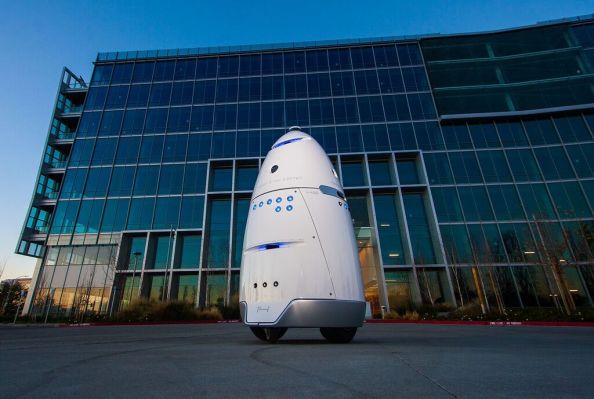Is it worse if a robot instead of a human is used to deter the homeless from setting up camp outside places of business?
One such bot cop recently took over the outside of the San Francisco SPCA, an animal advocacy and pet adoption clinic in the city’s Mission district, to deter homeless people from hanging out there — causing some people to get very upset.
Silicon Valley game developer and Congressional candidate Brianna Wu tweeted yesterday her dismay at the move, saying, “I’m sorry for being so frank but this absolutely disgusts me as someone that experienced homelessness.”
The homelessness issue in S.F. is thorny and complicated. One could get whiplash at seeing the excess of wealth and privilege juxtaposed with the dire circumstances just steps outside Twitter headquarters on Market Street.
However, the city’s homeless are also associated with higher rates of crime, violence and sometimes episodes of psychosis, leading to safety issues that many feel San Francisco has not had an adequate handle on.
The S.F. SPCA rolled out the use of a robot unit dubbed K9 from security startup Knightscope a month ago, citing these same safety concerns.
“Over the summer our shelter was broken into twice. The inside was vandalized and property and cash donations were stolen,” S.F. SPCA spokesperson Krista Maloney told TechCrunch. “Furthermore, many staff members and volunteers have filed complaints about damage to cars and harassment they experienced in our parking lot when leaving work after dark. We currently employ security guards, but we have a large campus and they can only be in one area at a time.”
The K9 units are also cheaper than humans. One robot costs $6 an hour to use vs. paying a security guard the average $16 an hour.
“Unfortunately, in the last year we’ve been forced to spend a significant amount of money to ensure the security and safety of the people on our campus as well as the animals in our care,” Maloney said.
And, according to both the S.F. SPCA and Knightscope, crime dropped after deploying the bot.
However, the K9 unit had its own share of hardships. The SPCA told TechCrunch it had been knocked over and someone had smeared BBQ sauce on it in early March. Another tweeter mentioned seeing poo smeared on the vehicle, though an SPCA spokesperson could not confirm that happened.
It’s worth mentioning many robots have been targeted by humans in the past. One of these same type of K9 units employed by the SPCA was brutally attacked by a drunken man, toppling the 400 pound robot on patrol in a Silicon Valley parking lot earlier this year.
Another issue looming over the bot cop’s employment at the SPCA was the use of a public sidewalk. The K9 unit was patrolling several areas around the shop, including the sidewalk where humans walk, drawing the ire of pedestrians and advocacy group Walk SF, which previously introduced a bill to ban food delivery robots throughout the city.
“We’re seeing more types of robots on sidewalks and want to see the city getting ahead of this,” said Cathy DeLuca, Walk SF policy and program director.
Last week the city ordered the S.F. SPCA to stop using these security robots altogether or face a fine of $1,000 per day for operating in a public right of way without a permit.
The S.F. SPCA says it has since removed the robot and is working through a permitting process. It has already seen “two acts of vandalism” since the robot’s removal.
But putting permits and public use of sidewalks aside, it seems the robot could do more than just discourage homeless camps. It could keep an eye on the surrounding area and report crimes, yes, but it could also possibly be used to alert police and social workers to areas where homelessness seems to have increased or look for anyone who may be facing violence or a psychotic episode and in need of intervention.
The Knightscope bots are equipped with four cameras able to read more than 300 license plates per minute. They can move about and keep tabs on an area, noting anyone on a list of those who shouldn’t be there.
Already the S.F. SPCA said it has experienced a drop in crime when using the bot cop. The same might be said if it had increased the use of human security guards but humans, as mentioned above, cost more. They also can’t monitor 24/7 or immediately upload what they see to the cloud.
Further, robots aren’t going away. While it isn’t clear what solution San Francisco’s city council will come up with to handle the increase of these types of bots on our sidewalks in the future, it’s inevitable we’re going to see more of them.
It’s an age-old human vs. machine argument. But machines usually win.
